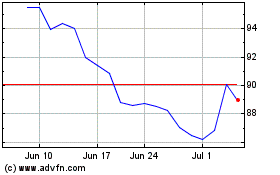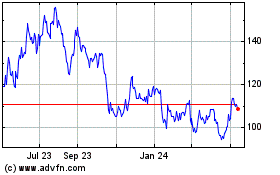BEIJING—As Chinese stocks continued to tumble in early trading
Monday, China looked to flood its banking system with new liquidity
to offset effects of its recent surprise currency devaluation,
according to Chinese officials and advisers to the central
bank.
Stocks fell sharply in morning trading, with the Shanghai
Composite Index opening 3.7% lower.
The expected move to free up more funds for lending—by reducing
the deposits banks must hold in reserve—is directly aimed at
countering the effects of a weaker currency, which could send more
funds away from Beijing's shores. The moves reflect an economy
increasingly failing to cooperate with Chinese leaders' playbook to
control the world's No. 2 economy.
Beijing's struggles this summer have spooked many investors into
viewing China as a threat to, rather than a rescuer of, global
growth. During the financial crisis of 2008 and early 2009, China,
with a colossal stimulus plan, acted as a shock absorber. Lately,
it is China that is providing the shocks.
Over the past week, it has grown clear how dependent a
growth-starved world is on China, which accounts for 15% of global
output but has contributed up to half of global growth in recent
years.
Given this dependency, one reason markets have been so unnerved
is that China's economy remains something of a black box. For
starters, analysts have long wondered about the accuracy of
government economic statistics. And levers pulled by Chinese policy
makers can be unconventional. This is seen in Beijing's desire to
micromanage the yuan's value, which undercuts its ability to pursue
an independent monetary policy because of spillover effects on
domestic liquidity.
The cut in bank reserves, which could come as early as this
week, would follow several others this year and four interest-rate
cuts since November that have failed to juice growth and channel
bank lending to the so-called real economy.
A key problem is that risk-averse banks continue to favor
state-owned companies, eschewing private enterprises with
less-traditional collateral and balance sheets. This often leaves
entrepreneurs with higher growth potential to fall back on
high-interest nonbank financing or go without. Meanwhile, many
state-owned companies, already awash in cheap capital, are
reluctant to borrow because of overcapacity in various
industries.
High-tech entrepreneurs say they are having even more difficulty
securing financing since the steep Chinese stock-market fall that
started in June, as investors grow more cautious. Zhong Shaofeng,
founder of a venture-capital firm in Shenzhen called Zhijin VC,
said that instead of asking wealthy individuals to commit large
sums for his latest startup investment fund, he has created a new
fund that invests small amounts in specific projects. In this
climate, "it's easier to ask more people for small amounts of
money," he said.
The People's Bank of China's latest planned move, which could
come before the end of this month or early next month, would
involve a half-percentage-point reduction in banks'
reserve-requirement ratio, potentially releasing 678 billion yuan
($106.2 billion) in funds for banks to make loans.
One option being considered at the PBOC is to aim the planned
reserve-requirement cut only at banks that lend significantly to
small and private businesses, the ones deemed key to the country's
future growth. Such strategies, however, haven't proved effective
in the past in channeling credit to particular borrowers.
On Friday, a long stream of bleak economic news from China
appeared to reach critical mass. When a private survey showed
manufacturing sentiment as the worst in six years, markets around
the world tanked. U.S. stocks suffered their worst one-day loss in
four years, oil futures hit multiyear lows and emerging-market
currencies gyrated on devaluation fears.
"Views about China's economic prospects appear to be shifting
from serious concern to near panic." said Eswar Prasad, a Cornell
University professor and former China head for the International
Monetary Fund.
China's economy is still growing at a fast clip compared with
Western nations. And China has a vast $3.7 trillion in
foreign-exchange reserves to help it weather shocks.
But its current target of 7% growth this year would be China's
slowest in about a quarter-century, and Beijing clearly doesn't
have the same control over its economy as it has demonstrated in
past years, such as during the financial crisis.
Earlier in 2015, Beijing hoped to use a rallying stock market to
channel funds to indebted companies. But when stocks fell in June
and July, a flurry of interventions to prop up the market just
exacerbated the impression of leaders losing control.
Then, after China devalued the yuan earlier this month,
surprised markets drove the yuan down more than Beijing expected,
prompting the central bank to intervene again.
Also this month, the government's slow response to a chemical
disaster in Tianjin added to a perception of wobbly crisis
management.
"The world is starting to realize China is not nearly as
competent as thought, especially in the economic sphere where
everyone gave it good grades," said Fraser Howie, co-author of "Red
Capitalism: The Fragile Financial Foundation of China's
Extraordinary Rise."
Some of the tools China has traditionally relied on to support
growth are losing effectiveness as their repeated use runs up
against structural inefficiencies and a larger economy. China's
$10.3 trillion economy in 2014 is five times its size a decade
ago.
"The room for fiscal expansion is rather limited," said a senior
economic adviser to China's leadership, adding that policy is less
effective as the economy gets bigger. "In the past, you would only
need one yuan of investment to achieve a certain growth rate, but
now it probably would require twice that amount," the adviser
said.
At just-completed summer talks at the northern seaside town of
Beidaihe, China's senior officials were divided over how to
stimulate the economy, according to people familiar with the
matter.
It wasn't a disagreement over whether to accept slower growth,
one of the people said. "The question is more about what to do to
reach the 7% growth target for this year," said this person, who
added: "The government has a much tougher job of maintaining growth
now compared to seven years ago."
The old recipe, relying on state investment and exports, is
losing effectiveness faster than expected. Exports fell 8.3%
year-over-year in July, factory orders are down, and construction
starts fell 16.8% over the first seven months of 2015 from a year
earlier.
Even China's car factories are feeling the squeeze, with General
Motors Co. and Volkswagen AG now running their plants in China
below full capacity for the first time.
New would-be drivers of the economy—high technology and
entrepreneurship—aren't filling the gap quickly enough.
In southern China, Shenzhen's Nanshan district is buzzing with
activity from hundreds of technology firms, from Internet giant
Tencent Holdings Ltd. to tiny startups confident of continued
growth in the Internet sector. But despite double-digit growth
rates, the sector's size isn't enough to replace the old economy
any time soon.
Chinese Internet-search company Baidu Inc., for example, has
roughly the same stock-market value as CRRC Corp.—a company formed
this year from the merger of China's two largest railway-equipment
makers—but has half the revenue and only one quarter the staff.
And some big-name Chinese technology companies are reporting
softening markets. Electronics maker Lenovo Group Ltd. called the
past quarter "perhaps the toughest market environment in recent
years."
Phone maker Xiaomi Corp., which had ridden the wave of
first-time smartphone buying in China to rack up triple-digit
growth in recent years, now has to look for such growth elsewhere.
For the first time in six years, China's smartphone sales are
declining.
The lights are dimming for some old-economy industries. In an
energy sector that for decades scrambled to keep up with demand
from China's factories, companies such as state-controlled power
producer Huadian Power International Corp. are reporting sharply
falling production as manufacturers close.
In an industrial suburb of Chengdu, Huang Mingjian's income from
a laundry service he opened 17 years ago has fallen by a third as
the main source of his livelihood, a nearby steel plant, is
preparing to close. "I've been feeling the business pressure for
months," Mr. Huang said.
As some factories close and construction projects stand idle,
the flow of migrant workers to cities is starting to reverse,
particularly in China's northeast, according to labor
activists.
A construction worker who gave his name as Bao said he left
Shenyang, the capital of Liaoning province, to return to his
hometown about two months ago. "Things started to get worse from
the middle of last year. Many construction projects were halted,
and those that continued paid workers less," said the 34-year-old
Mr. Bao. "Many of my friends have left as well."
China's government says that nationwide, employment is holding
up well. Still, according to China Labour Bulletin, a Hong
Kong-based watchdog, the number of worker protests and strikes more
than doubled in the second quarter from a year earlier.
As various levels of government in China are struggling to repay
debt, fiscal problems are especially acute in Liaoning. The
province's revenue plunged 23% in the first half of this year.
Within the PBOC, doubts remain about the effectiveness of more
bank-reserves cuts, according to Chinese officials and advisers to
the central bank. "The central bank would have preferred not to
flood the market again with liquidity, if only it had a choice,"
said an official close to the central bank.
Subscribe to WSJ: http://online.wsj.com?mod=djnwires
(MORE TO FOLLOW) Dow Jones Newswires
August 23, 2015 22:55 ET (02:55 GMT)
Copyright (c) 2015 Dow Jones & Company, Inc.
Baidu (NASDAQ:BIDU)
Historical Stock Chart
From Mar 2024 to Apr 2024

Baidu (NASDAQ:BIDU)
Historical Stock Chart
From Apr 2023 to Apr 2024
